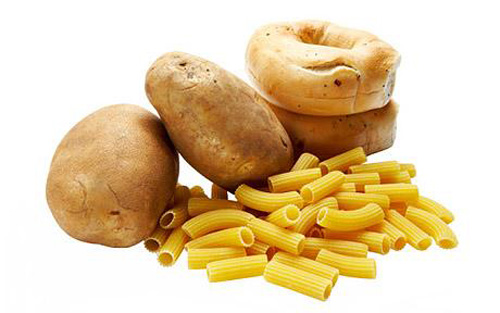Carbohydrates are sugars, starches, and fibers found in most foods. While they are perhaps most famous for their role in fueling our body’s energy needs, carbohydrates (often referred to as “carbs”) actually serve a wide variety of purposes in the body, including regulation of digestion, enabling of communication between cells, and support of immune functions.
Carbohydrates are composed of carbon, hydrogen, and oxygen, which are arranged into small units called sugars, or monosaccharides. Small carbohydrates, like glucose or sucrose (table sugar) are composed of one or two sugar units, respectively, and are the molecules that give food a sweet taste. These molecules are sometimes called “simple sugars” because they are small (only one or two units), and are quickly digested, providing immediate energy to the body.
Larger carbohydrate molecules, which include fibers and starches, are composed of at least twenty or more monosaccharides linked together. These large carbohydrates, called polysaccharides (poly=many) may contain up to several hundred monosaccharides linked together in different ways. Another term commonly used to describe carbohydrates is oligosaccharides, a type of carbohydrate molecule that is in between polysaccharides and monosaccharides in size, and features three to twenty monosaccharides bonded together. You might also hear the term “disaccharides” when carbs are mentioned, and this term refers to molecules that contain two simple sugars.
Protein: The word protein was coined by the Dutch chemist Geradus Mulder in 1838 and comes form the Greek word “protos” which means “of prime importance”. Your body, after water, is largely made up of protein. Protein is used by the body to build, repair and maintain muscle tissue. Protein is comprised of amino acids, usually referred to as the “building blocks of protein”. There are approximately 20 amino acids, 9 of which are considered essential because the body cannot make them, they must be supplied by the diet.
Protein is essential for growth and the building of new tissue as well as the repair of broken down tissue – like what happens when you work out. When you hear the term “positive nitrogen balance”, it refers to being in a state of having enough protein available for the needs of the body and the needs of building muscle. What does nitrogen have to do with protein? Nitrogen is one of the most important elements in all protein (Taber’s Cyclopedic Medical Dictionary, p. n-31). It is essential to animal life for tissue building – this statement alone defines the key need for protein when lifting weights.
For the most part, we are told to eat sufficient protein (every 3-4 hours) to maintain a positive nitrogen balance because your body is actually in an anabolic, or building up phase in this state, where a negative nitrogen balance, from lack of adequate protein, indicates a catabolic, or tearing down state. This is why protein (and eating enough through out the day) is so important: lack of adequate protein, and your body begins to break down tissue (read: muscle) to meet it’s daily protein needs. Our bodies constantly assemble, break down and use proteins (in the form of amino acids, the building blocks of protein), in fact there are literally thousands of different protein combinations used by the body, each one has a specific function determined by it’s amino acid combination (or amino acid sequence).
Virtually all modern authorities agree that 1 to 11/2 grams of protein per lb. of body weight is best for muscle growth. Besides taking in high quality protein from food (lean beef, chicken, turkey, fish, eggs), the best way to keep your protein intake at the proper levels are through the use of protein shakes. The other part of getting the most out of your protein intake and thereby maintaining a positive nitrogen balance is carb and fat intake, both are needed in reasonable amounts to insure protein synthesis.
As far as powders are concerned, whey protein is the best quality, meaning your body will absorb and use more of it. There are several types of whey (isolate, concentrate, hydrolysate), but whey protein isolate remains number one because of it’s high quality. But milk based proteins are making a comeback, largely because of there longer lasting effects in the body: whey is typically touted as a fast digesting protein, milk as a slow digesting protein.
Let me sidetrack for a minute and clear up a common misconception, and pet peeve of mine, regarding grams of protein advertised as being in a basic protein powder (not a “formula” product like Muscle Milk or Syntha 6 which contains more fat and carbs). People always judge a protein powder by the number of advertised grams per serving: “This one only has 17 grams, it’s not as good as this one that has 50 grams!” Wrong, wrong, wrong. Protein contains 4 calories per gram, that’s how it’s measured, meaning that it doesn’t matter what the label says, they are using different scoop sizes and numbers of scoops per serving to get that advertised amount.
Since protein is 4 calories per gram, and scoop sizes are measured in grams, if you used a standard scoop size and quantity, you would get the same amount of protein regardless of the brand name (excepting minor variances for fat and carb content). Test this out yourself, the next time you’re at the vitamin store, compare protein labels. Note the protein, carb and fat per serving. Now note the scoop size and how many scoops equal one serving. You will see that any label with a high advertised protein content is using a large scoop and probably 2 scoops a serving. A smaller scoop and serving amount corresponds to a protein with a lower advertised amount. Don’t be fooled into thinking the 50 grams per serving product is better, they are using a very big scoop to give you that much protein! Base your choice on product quality!
Now let’s get back to my main topic regarding protein. The timing of protein is the key to maintaining a positive nitrogen balance and staying in an anabolic state. You should take in protein every 3 – 4 hours, your protein intake should be evenly divided up throughout the day over the course of 5-6 meals. This can be three main meals and 2-3 high protein snacks or shakes.
Other than that, there are some critical times to take in protein – first thing in the morning, with some simple carbohydrates because you have not eaten since the evening before and your body is in a catabolic state, you should also be sure to take in a protein shake with fast carbs – like fruit – about 1 hour before you train and you should take in a similar shake after you train – this should be, by the way, 40-60 grams of protein and about the same in carbs. Finally, you should have a small protein shake or meal before bed, because during the night you typically fall into a catabolic state.
– See more at: https://www.championboxingclub.com/papa-johns-health-tips/#sthash.hIcDCxAc.dpuf

